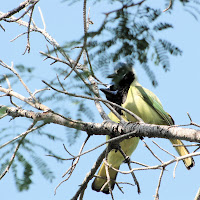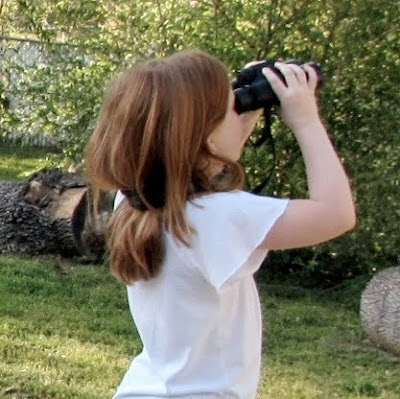 First, you may have noticed that I changed the photograph behind the blog's title above. The Black-bellied Whistling Ducks are just so much fun to watch that I wanted them to look over the page. (See this earlier post for other photos.) Every morning they stand or sit on the railing of the deck by the river, waiting for the neighbors to put out seed. Today while my husband fished on the dock, I walked up the stairs to the deck where the ducks had perched, to within ten feet of them, and they didn't move -- until I started talking too loudly and they flew in their awkward way to the next dock.
First, you may have noticed that I changed the photograph behind the blog's title above. The Black-bellied Whistling Ducks are just so much fun to watch that I wanted them to look over the page. (See this earlier post for other photos.) Every morning they stand or sit on the railing of the deck by the river, waiting for the neighbors to put out seed. Today while my husband fished on the dock, I walked up the stairs to the deck where the ducks had perched, to within ten feet of them, and they didn't move -- until I started talking too loudly and they flew in their awkward way to the next dock.I'll be happy to see the ducks bring their family along with them later in the summer. I'm not sure where the nest is--they are still spending much of the day here, so they may not have a nest yet. Last summer I thought maybe they had nested on top of a neighbor's old shed where they spent a lot of time.
 Other nesting news: Northern Mockingbirds have completed a nest in a small Anacua tree in the yard just to the east. Another pair of mockingbirds are close by, perhaps in the yard to the west. Brown-crested Flycatchers still take dried grass into a small hanging bird house though its proximity to the garage makes them nervous. The Altamira Orioles, Hooded Orioles, and Kiskadees are relatively quiet, not much movement in and out of the nests. That may mean they are sitting on eggs. Of course, cowbirds keep close watch on all and harass them continually. Green Jays today followed each other around the tree canopy over the driveway, ruffling up their feathers and almost snuggling. I know of no nest yet, but there must be one close by. A pair of Northern Cardinals are also eating at feeders in the yard off and on all day. They are certainly nesting nearby also. The Curved-bill Thrashers are probably sitting on eggs by now in their nest in the neighbor's yucca.
Other nesting news: Northern Mockingbirds have completed a nest in a small Anacua tree in the yard just to the east. Another pair of mockingbirds are close by, perhaps in the yard to the west. Brown-crested Flycatchers still take dried grass into a small hanging bird house though its proximity to the garage makes them nervous. The Altamira Orioles, Hooded Orioles, and Kiskadees are relatively quiet, not much movement in and out of the nests. That may mean they are sitting on eggs. Of course, cowbirds keep close watch on all and harass them continually. Green Jays today followed each other around the tree canopy over the driveway, ruffling up their feathers and almost snuggling. I know of no nest yet, but there must be one close by. A pair of Northern Cardinals are also eating at feeders in the yard off and on all day. They are certainly nesting nearby also. The Curved-bill Thrashers are probably sitting on eggs by now in their nest in the neighbor's yucca. Every morning, a large male Wild Turkey flies over from across the river to walk around (and gobble) in the yard . Today he flew to an entry deck behind the house, not far from where Brad was fishing on the dock. They gobbled at each other for a bit (I wonder what the bird thought of the fisherman) and then the turkey moved around the house to stroll the driveway. Brad also saw bottlenose dolphins this morning feeding in the river. I'm hoping to catch them in a photo soon. The dolphins are one of my favorite things about the river.
The last few days have been good ones for watching spring migrants. Six new species have been added to the 2010 Yard List since Monday. (The list is to the right in the sidebar. I always set the recent additions in red.)
A beautiful male Rose-breasted Grosbeak has been in the yard for a couple of days. He's not eating the orange half that's in the photo, of course--that's for the five species of orioles, Great-tailed Grackles, Green Jays, and woodpeckers. He's partial to the sunflower seeds. That's a picture of a grosbeak female to the right. These birds are a little skittish and shy at first, but once they find a feeder with large striped sunflowers, they settle in and eat for as long as there's still seed. I think their large seed-cracking beaks make them look comical.
Female and juvenile Rose-breasted Grosbeaks look similar to the male Black-headed Grosbeaks we sometimes have in the winter. (Look at this post for a photo of last January's first-year male.)
(Yesterday was actually a two-grosbeak day when a Blue Grosbeak flew in very briefly. Rust-red wing bars distinguish it from the very similar Indigo Bunting. )
The best migrant news is that the Painted Buntings are here. Monday I saw a male fly out of the drive and across the road to the patch of weeds beside the sorghum field. I watched from the deck for awhile, and when it didn't appear again, I walked to the end of the drive and was lucky enough to get photos. Not great photos --- since they were taken from across the road, but any picture of a Painted Bunting, even if fuzzy and small, is fun to look at--just like the birds. So brightly colored with red breasts, blue heads and wings, red eye-rings and green backs, these birds do not look real but like they were drawn by a child with a brand new box of crayons.

In the picture on the left, a second bunting hides behind another. Until I downloaded the photo to my computer, I thought I had seen just one bird! Arching above the birds in the picture is a seed-head of guinea grass that had grown up around a stand of century plants. An invasive plant that gardeners around here battle continually, guinea grass is tenacious and tough to pull up. If you let it grow too long (if you're a lazy gardener like me) you have to dig the clumps out of the ground with a shovel. I know I shouldn't, but I let them go to seed when the buntings are migrating because that's where I always see the beautiful birds-- in the untidy clumps of grass in my yard. (I guess pulling a few in my yard wouldn't help much anyway since across the road there's plenty of it. )
Yesterday was actually a two-grosbeak day when a Blue Grosbeak flew in very briefly. Rust-red wing bars distinguish it from the very similar Indigo Bunting. I hope I have a chance for a photo if it returns.
Not all the birds of the yard are as brightly colored as the Painted Bunting. But the eye of the Bronzed Cowbird is as red as the bunting's brightest feathers. Look at the ruff of feathers around this guy's neck that he can puff up when he really wants attention. (If it were not late as I write this, I'd talk more about this amazing ---but not beloved-- bird. I'll put that off for another time when I'm not just giving a yard report.)
Other new birds I've seen and added to the 2010 Year List since my last report : Western Kingbirds perching at the top of the Royal Poinciana ; a Swainson's Hawk soaring high above the fields; and a Willow Flycatcher making quick forays over the driveway to catch bugs from a perch in a mesquite. (The flycatcher obligingly sang as it flew away so that I could tell it was a Willow and not an Alder. Usually I have no idea which of those two little flycatchers I'm seeing.)
Well, that's the end of this installment of the backyard report.
To borrow from Garrison Keillor: That's the news from the Arroyo Colorado...where all the women are strong, all the men are good-looking and all the birds are above average.


















































